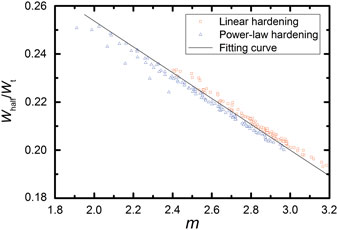Crossref Citations
This article has been cited by the following publications. This list is generated based on data provided by
Crossref.
Zhang, Taihua
Cheng, Wenqiang
Peng, Guangjian
Ma, Yi
Jiang, Weifeng
Hu, Jiangjiang
and
Chen, Heng
2019.
Numerical investigation of spherical indentation on elastic-power-law strain-hardening solids with non-equibiaxial residual stresses.
MRS Communications,
Vol. 9,
Issue. 1,
p.
360.
Peng, Guangjian
Xu, Fenglei
Chen, Jianfeng
Hu, Yahao
Wang, Huadong
and
Zhang, Taihua
2020.
A cost-effective voice coil motor-based portable micro-indentation device for in situ testing.
Measurement,
Vol. 165,
Issue. ,
p.
108105.
Peng, Guangjian
Xu, Fenglei
Chen, Jianfeng
Wang, Huadong
Hu, Jiangjiang
and
Zhang, Taihua
2020.
Evaluation of Non-Equibiaxial Residual Stresses in Metallic Materials via Instrumented Spherical Indentation.
Metals,
Vol. 10,
Issue. 4,
p.
440.
Chen, Hui
Cai, Li-xun
and
Li, Chuanxi
2020.
An elastic-plastic indentation model for different geometric indenters and its applications.
Materials Today Communications,
Vol. 25,
Issue. ,
p.
101440.
2021.
Testing of the Plastic Deformation of Metals.
p.
148.
Burley, Max
Campbell, Jimmy E
Reiff-Musgrove, Rebecca
Dean, James
and
Clyne, Trevor William
2021.
The Effect of Residual Stresses on Stress–Strain Curves Obtained via Profilometry‐Based Inverse Finite Element Method Indentation Plastometry.
Advanced Engineering Materials,
Vol. 23,
Issue. 5,
Zhang, Tairui
Li, Jianxun
Sun, Xun
Shang, Xiandong
and
Wang, Weiqiang
2022.
Improving the tensile property calculations with plastic zone radius measurements in depth-sensing spherical indentation tests.
The Journal of Strain Analysis for Engineering Design,
Vol. 57,
Issue. 7,
p.
513.
Peng, Guangjian
Liu, Yu
Xu, Fenglei
Jiang, Hanyang
Jiang, Weifeng
and
Zhang, Taihua
2023.
On determination of elastic modulus and indentation hardness by instrumented spherical indentation: influence of surface roughness and correction method.
Materials Research Express,
Vol. 10,
Issue. 8,
p.
086503.
Zhang, Tairui
Li, Jianxun
Yang, Bin
Pei, Xianjun
and
Jiang, Wenchun
2023.
An incremental indentation energy method in predicting uniaxial tensile properties of ferritic-austenitic dissimilar metal welds from spherical indentation tests.
International Journal of Pressure Vessels and Piping,
Vol. 202,
Issue. ,
p.
104886.
Zhao, Hongjun
and
Wu, Bin
2023.
Three-dimensional face reconstruction of static images and computer standardization issues.
Soft Computing,
Vol. 27,
Issue. 2,
p.
1143.
Xu, Fenglei
Dou, Guijing
Chen, Jianfeng
Jiang, Hanyang
Zhang, Taihua
and
Peng, Guangjian
2024.
A Correction Function to Improve the Accuracy of Measuring Elastic Modulus by Instrumented Spherical Indentation.
Journal of Testing and Evaluation,
Vol. 52,
Issue. 4,
p.
20230320.






